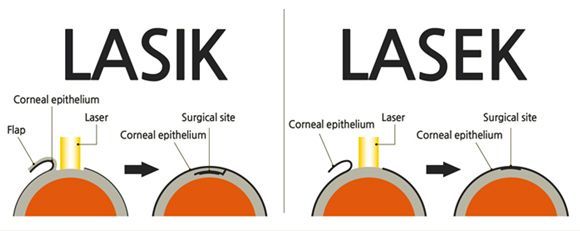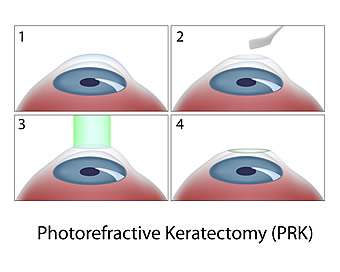Blog post by: Eye Physicians of Long Beach

Are you tired of relying on glasses and contact lenses? A procedure called LASIK is one of the most popular forms of vision correction available.
LASIK has helped millions of people eliminate their dependence on glasses and contacts by correcting their refractive errors. These include farsightedness, nearsightedness, and astigmatism.
Yet, as popular as LASIK is, it’s not something everyone is a good candidate for. However, the good news is that there are other laser vision correction procedures you may qualify for, like PRK or LASEK.
LASIK, LASEK, and PRK have similar outcomes and high success rates. However, there are some critical differences between the three. Keep reading to learn more about LASEK and PRK and how they compare to LASIK.
What is LASEK?

LASEK is a laser vision correction procedure that corrects nearsightedness, farsightedness, and astigmatism. The first step in LASEK involves applying a solution to your eye to separate the top layer of the cornea or epithelium from the other layers.
This thin layer is then carefully scraped to the side with a special tool. Using a laser, the surgeon reshapes the exposed cornea to correct your refractive error.
After completing this, they reposition the epithelium before putting a bandage contact lens on the eye. The contact lens helps keep the epithelium in place as it heals.
How Does LASEK Compare to LASIK?
While both LASEK and LASIK utilize a laser to reshape your eye, the procedures vary in how they achieve this. A tiny flap is created in the epithelium during LASIK to access the layers below.
Creating a flap in the epithelium allows your surgeon to reshape the underlying corneal tissue and correct your vision. Finally, the corneal flap is put back in place.
During LASEK, the epithelium is loosened, moved to the side, and reattached. The outer layer regenerates itself about 3 to 5 days after the procedure.
You’re likely to feel some discomfort during the initial recovery period. With LASIK, the corneal flap reseals itself in about 24 hours, and your vision will be clear very quickly.
For most patients, this is almost immediately or within a day. Generally, LASEK has a longer recovery time than LASIK and is a more invasive procedure.
What are the Advantages of LASEK?
Some of the benefits of LASEK include the following:
Ideal for Patients Who Don’t Qualify for LASIK
LASEK can be a great alternative if you’re severely nearsighted or have pre-existing medical conditions, and LASIK isn’t an appropriate solution.
Can Improve Vision if You Have Thinner Corneas
You might not be suitable for LASIK because your corneas are too thin. LASIK involves creating a flap in the cornea to correct vision.
However, to create the flap, you need to have corneas that are thick enough. If your corneas are too thin, it can result in severe consequences for your vision. Because LASEK doesn’t remove as much corneal tissue as LASIK does, it’s safer for patients with thinner corneas.
Reduced Risk of Dry Eyes

Corneal nerves in the eyes tend to heal faster after LASEK. Because these nerves aid in lubricating your eyes, dry eyes are less common after LASEK than LASIK.
What is PRK?
PRK is a refractive procedure that treats farsightedness, nearsightedness, and astigmatism. During the procedure, the epithelium is completely removed and discarded.
Next, the surgeon reshapes the exposed cornea with a laser. The epithelium is finally left to regrow naturally. A bandage contact lens is placed over your eye to protect it while the epithelium regenerates.
How PRK Compares to LASIK

PRK doesn’t need the creation of a corneal flap, unlike LASIK. Instead, the surgeon removes the top layer of the cornea.
Most people can resume their usual routines the next day after LASIK. With PRK, the recovery time is a bit longer due to the procedure requiring the complete removal of the epithelium.
Advantages of PRK
Some of the benefits of undergoing PRK include the following:
More Suitable for Thinner Corneas
If your corneas aren’t thick enough for LASIK, your surgeon will likely tell you to consider an alternative procedure that’s less risky. Luckily, PRK can be a good option for patients with corneas that are too thin to undergo LASIK safely.
No Flap Complications
There is potential for the flap created during LASIK to become dislodged during recovery. With PRK, this isn’t an issue because there is no flap.
Still, you’ll need to follow all instructions from your eye doctor after the procedure, including being careful with your eyes to ensure a smooth and successful recovery.
Better for Chronic Dry Eye
The flap made during LASIK can irritate your eyes and worsen your dry eye symptoms. For this reason, your surgeon might suggest PRK if you have chronic dry eyes.
You Can Still Have It with Pre-Existing Health Conditions
Diabetes or certain autoimmune conditions may disqualify you from LASIK. When that’s the case, PRK could be a better alternative to correct your vision.
No Flap Problems Later On

When you have LASIK, the flap could get dislodged if you engage in intense contact even after fully healing from LASIK. These flap complications may arise if you’re an athlete or perform strenuous workouts frequently.
If you’re incredibly active or someone that’s at high risk for injury or trauma to the eye, PRK may be recommended because there’s no flap.
Not A Good LASIK Candidate? You Have Options
You shouldn’t be discouraged if you don’t qualify for LASIK. At Eye Physicians of Long Beach, we offer PRK and LASEK, making it easier than ever to achieve visual freedom from glasses and contacts.
Want to put dependence on visual aids behind you? Schedule a consultation at Eye Physicians of Long Beach in Long Beach, CA, to find the best vision correction procedure for you!
